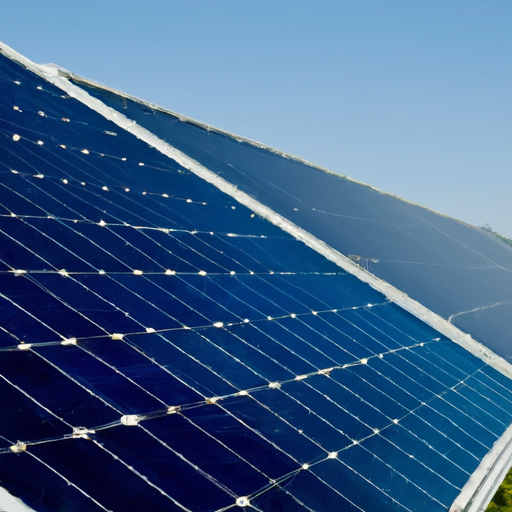

Have you ever wondered if solar energy storage systems can be used in off-grid applications? Well, you’re in luck because today we’re going to dive into this fascinating topic. So, sit back and get ready to learn more about how these systems can potentially revolutionize off-grid living.
When it comes to off-grid applications, having a reliable and efficient source of energy is crucial. And that’s where solar energy storage systems come into play. These systems allow you to capture and store the energy generated by solar panels, so you can use it during times when the sun isn’t shining or during peak demand periods. This means that even if you’re out in the middle of nowhere or facing a power outage, you can still have electricity to power your appliances, lights, and more.
But wait, there’s more! In this article, we’ll be delving deeper into the different types of solar energy storage systems available and exploring their benefits and limitations. We’ll also discuss the technology behind these systems, including battery storage solutions, and how they can be integrated into off-grid setups. So, if you’re curious about how to make the most out of solar energy in off-grid applications, keep reading because you’re in for a treat!


Overview of Off-grid Applications
Definition and purpose of off-grid applications
Off-grid applications refer to systems that operate independently from the main power grid, generating and storing their own energy. These systems are commonly used in remote locations where access to the grid is limited or non-existent. The purpose of off-grid applications is to provide a reliable and sustainable energy source, ensuring that essential services such as lighting, heating, and communication can be powered even in areas without grid connectivity.
Common off-grid applications
Off-grid applications are utilized in various sectors including residential, commercial, industrial, and agricultural settings. In the residential sector, off-grid systems are used for powering houses, cabins, and remote vacation homes. In the commercial and industrial sectors, off-grid applications are employed in telecommunications, mining operations, and remote research facilities. Additionally, off-grid systems find extensive use in agriculture for irrigation, livestock management, and crop drying.
Advantages and challenges of off-grid systems
Off-grid systems offer several advantages over traditional grid-connected systems. Firstly, they provide energy access in remote areas, thus improving the quality of life for individuals living in these regions. Moreover, off-grid applications reduce dependence on fossil fuels, contributing to a greener and more sustainable future. Furthermore, off-grid systems offer increased resilience and reliability, as they are not affected by power outages or fluctuations in the main grid.
However, off-grid systems also face their fair share of challenges. One of the main challenges is the higher upfront cost of setting up off-grid applications compared to grid-connected systems. Additionally, off-grid systems require appropriate sizing and maintenance to ensure optimal performance. The proper management of battery storage, in particular, is crucial for the success of off-grid applications.
Introduction to Solar Energy Storage Systems
Explanation of solar energy storage systems
Solar energy storage systems, also known as solar battery systems, are an integral part of off-grid applications. These systems enable the storage of excess energy generated by solar panels during the day for use during the night or when sunlight is limited. By storing solar energy in batteries, off-grid systems can provide a stable and continuous power supply even in the absence of sunlight.
Components of a solar energy storage system
A typical solar energy storage system consists of three main components: solar panels, an inverter, and batteries. Solar panels capture sunlight and convert it into electricity. The inverter transforms the direct current (DC) electricity generated by the solar panels into alternating current (AC) electricity that can be used by electrical appliances. The batteries store the excess energy generated by the solar panels for later use, ensuring a consistent power supply.
Types of batteries used in solar energy storage
Several types of batteries are used in solar energy storage systems. Lead-acid batteries are the most commonly used and are cost-effective. They are available in two variants: flooded lead-acid batteries and sealed lead-acid batteries. Flooded lead-acid batteries require regular maintenance and venting, while sealed lead-acid batteries are maintenance-free. Lithium-ion batteries are another popular choice due to their high energy density, longer lifespan, and faster charging capabilities. However, they tend to be more expensive than lead-acid batteries.
Integration of Solar Energy Storage Systems in Off-grid Applications
Benefits of using solar energy storage systems in off-grid applications
Integrating solar energy storage systems in off-grid applications offers numerous benefits. Firstly, these systems provide a consistent and reliable power supply, eliminating the reliance on fossil fuels or the main grid. This reduces energy costs and the environmental impact associated with traditional energy sources. Additionally, solar energy storage systems enhance energy independence, enabling individuals and businesses to have complete control over their energy production and consumption.
Considerations when integrating solar energy storage systems into off-grid applications
When integrating solar energy storage systems into off-grid applications, several considerations must be taken into account. Proper sizing of the system is crucial to meet the energy demands of the application. The capacity of the batteries should be carefully calculated to ensure sufficient energy storage for times when the solar panels cannot generate electricity. Additionally, the location and orientation of the solar panels must be optimized to maximize sunlight exposure and energy generation.
Technological advancements and innovations in solar energy storage systems
The field of solar energy storage systems has witnessed significant technological advancements and innovations in recent years. The efficiency and performance of solar panels have improved, allowing for increased energy generation. Inverter technology has also evolved, with advanced models offering better conversion efficiency and power management capabilities. Moreover, battery technology has seen significant improvements, with higher energy densities, longer lifespans, and enhanced safety features.


Case Studies: Successful Implementation of Solar Energy Storage Systems in Off-grid Applications
Case study 1: Off-grid residential system with solar energy storage
In a remote residential area without access to the main power grid, an off-grid system with solar energy storage was implemented. Solar panels were installed on the roof of the house to capture sunlight and convert it into electricity. The excess energy generated during the day was stored in batteries for use during the night. This system provided a reliable and sustainable power supply, ensuring that the residents had access to electricity for lighting, heating, and other essential needs.
Case study 2: Solar-powered off-grid telecom tower
In a remote area where the establishment of a traditional power grid was not feasible, a solar-powered off-grid system was deployed to power a telecom tower. Solar panels were installed near the tower to generate electricity from sunlight. The energy generated during the day was stored in batteries, ensuring a continuous power supply for the telecom equipment. This off-grid system not only provided reliable communication infrastructure but also reduced operating costs and carbon emissions.
Case study 3: Off-grid agricultural applications with solar energy storage
In agricultural settings, off-grid systems with solar energy storage have been successfully implemented for various applications. For example, solar-powered water pumps have been installed in remote areas for irrigation purposes. The solar panels generate electricity to power the pumps, while excess energy is stored in batteries for use during non-sunlight hours. These off-grid systems provide a reliable and sustainable water supply for the irrigation of crops, enhancing agricultural productivity and reducing dependence on conventional energy sources.
Economic Viability and Cost Analysis
Cost considerations of solar energy storage systems
When evaluating the economic viability of solar energy storage systems in off-grid applications, cost considerations play a crucial role. The initial investment for installing solar panels, inverters, and batteries can be significant. However, it is essential to consider the long-term benefits and savings associated with reduced energy costs, lower maintenance requirements, and the potential for selling excess energy back to the grid. Additionally, advancements in technology and economies of scale are leading to a decrease in the cost of solar energy storage systems over time.
Comparison of costs between traditional off-grid systems and solar energy storage systems
When comparing the costs of traditional off-grid systems, such as diesel generators or propane-based systems, with solar energy storage systems, the latter often proves to be more cost-effective in the long run. While the upfront costs of solar energy storage systems may be higher, the absence of fuel costs and the reduced maintenance requirements contribute to long-term savings. Additionally, the declining costs of solar panels and batteries further improve the economic feasibility of solar energy storage systems.
Return on investment and payback period analysis
Determining the return on investment (ROI) and payback period of solar energy storage systems in off-grid applications is essential for decision-making. ROI is calculated by comparing the initial investment with the savings generated over a specific period. The payback period refers to the time required for the savings generated to equal the initial investment. Factors such as energy consumption, system efficiency, and maintenance costs influence the ROI and payback period. In general, solar energy storage systems in off-grid applications have shown competitive ROI and relatively shorter payback periods in recent years.
Environmental Impact and Sustainability
Benefits of using solar energy storage systems in reducing carbon footprint
Solar energy storage systems play a significant role in reducing carbon footprints and promoting sustainable energy practices. By harnessing solar power, the reliance on fossil fuels is minimized, thereby reducing greenhouse gas emissions. The use of solar energy storage systems in off-grid applications helps mitigate the environmental impact associated with traditional energy generation and consumption. Moreover, the installation of these systems contributes to the development of a cleaner and more sustainable energy infrastructure.
Life cycle analysis and environmental considerations
Life cycle analysis (LCA) is an essential tool for evaluating the environmental impact of solar energy storage systems. LCA assesses the energy and resource inputs, emissions, and waste generated throughout the life cycle of the system, including production, operation, and disposal. Environmental considerations in the design and production of solar energy storage systems, such as the selection of recyclable and non-toxic materials, are crucial for minimizing their environmental impact. Proper end-of-life management, including recycling and proper disposal of components, ensures the sustainability of these systems.
Role of solar energy storage systems in achieving sustainable development goals
Solar energy storage systems are instrumental in achieving the United Nations Sustainable Development Goals (SDGs). These systems contribute to SDG 7: Affordable and Clean Energy, by ensuring access to reliable and sustainable energy sources in remote areas. Additionally, solar energy storage systems contribute to SDG 13: Climate Action, by reducing carbon emissions and promoting renewable energy adoption. By harnessing solar power, off-grid communities can improve their living conditions, enhance economic opportunities, and contribute to a more sustainable future.
Regulatory and Policy Framework
Government incentives and subsidies for off-grid solar energy storage systems
Many governments around the world have implemented various incentives and subsidies to promote the adoption of off-grid solar energy storage systems. These incentives include tax credits, grants, and subsidies that reduce the upfront costs and improve the economic feasibility of such systems. Additionally, net metering programs allow off-grid system owners to sell excess energy back to the grid, further incentivizing the use of solar energy storage systems.
Regulatory requirements for off-grid applications
Regulatory requirements for off-grid applications vary depending on the country and jurisdiction. These requirements typically involve safety standards, electrical codes, and permitting processes that ensure the proper installation and operation of off-grid systems. Compliance with these regulations is essential to ensure the safety and reliability of off-grid applications.
Policy initiatives to promote the adoption of solar energy storage systems
To encourage the adoption of solar energy storage systems, policymakers are implementing various policy initiatives. These initiatives include renewable energy targets, feed-in tariffs, and energy efficiency programs. By supporting the development and deployment of solar energy storage systems, policymakers aim to accelerate the transition to a cleaner, more sustainable energy future.
Technological Challenges and Solutions
Issues and limitations of solar energy storage systems
Despite their numerous benefits, solar energy storage systems face certain issues and limitations. One of the main challenges is the intermittency of solar power generation, as it depends on sunlight availability. This requires proper sizing and management of the system for reliable energy supply. Additionally, the management and disposal of batteries, which contain hazardous materials, require careful attention to environmental and safety considerations.
Research and development efforts to address technological challenges
Researchers and manufacturers are actively working to address the technological challenges associated with solar energy storage systems. Efforts are focused on improving the efficiency and performance of solar panels, enhancing battery technologies, and developing advanced power management systems. Ongoing research and development aim to increase the energy generation capacity, lifespan, and safety of these systems.
Emerging trends in solar energy storage system technologies
Several emerging trends in solar energy storage system technologies are shaping the future of off-grid applications. These include the integration of artificial intelligence and machine learning for optimized energy management, the use of advanced materials to improve the efficiency of solar panels, and the development of new battery chemistries with higher energy densities. Furthermore, the integration of solar energy storage systems with other renewable energy sources, such as wind and hydro power, is gaining traction for a more diversified and reliable energy supply.
Maintenance and Operations
Best practices for maintenance and operations of solar energy storage systems
Proper maintenance and operation of solar energy storage systems are essential to ensure their optimal performance and longevity. Best practices for maintenance include regular inspections of the solar panels, cleaning to remove dust and debris, and ensuring the integrity of electrical connections. Battery maintenance involves monitoring the charge levels, checking for signs of deterioration, and replacing batteries when necessary. Additionally, regular system performance monitoring and prompt troubleshooting of issues are crucial for efficient operation.
Monitoring and troubleshooting techniques
Monitoring techniques such as remote system monitoring and data analytics play a vital role in ensuring the efficient operation of solar energy storage systems. Remote monitoring allows for real-time monitoring of system performance and early detection of any anomalies. Data analytics help identify patterns and optimize system performance. Troubleshooting techniques involve identifying and rectifying issues related to the solar panels, inverters, batteries, and electrical connections.
Safety considerations for off-grid solar energy storage systems
Safety considerations are paramount when it comes to off-grid solar energy storage systems. These systems involve electrical components and potentially hazardous batteries. Proper training and certification of installers and maintenance personnel are crucial to ensure safe installation and operation. Additionally, safety features such as overcharge and discharge protection, temperature regulation, and fire suppression systems must be incorporated into these systems to mitigate risks.
Conclusion
Summary of key findings
Solar energy storage systems have proven to be highly effective in off-grid applications, providing a reliable and sustainable energy source. The integration of these systems offers numerous benefits, including energy independence, cost savings, and reduction in carbon emissions. Advancements in technology and policy support have further improved the economic viability and environmental sustainability of solar energy storage systems.
Future prospects of solar energy storage systems in off-grid applications
The future of solar energy storage systems in off-grid applications looks promising. Continued advancements in technology, such as higher efficiency solar panels and advanced battery chemistries, will further improve the performance and economic feasibility of these systems. Additionally, policy support and increasing awareness of the benefits of renewable energy will drive the adoption of solar energy storage systems in both off-grid and grid-connected applications.
Importance of sustainable and reliable energy solutions
The importance of sustainable and reliable energy solutions cannot be overstated. Off-grid applications, powered by solar energy storage systems, offer a viable and sustainable alternative to traditional energy sources. These systems enable individuals and communities in remote areas to have access to electricity, improving their quality of life and economic opportunities. Furthermore, the adoption of renewable energy contributes to mitigating climate change and achieving global sustainable development goals.



